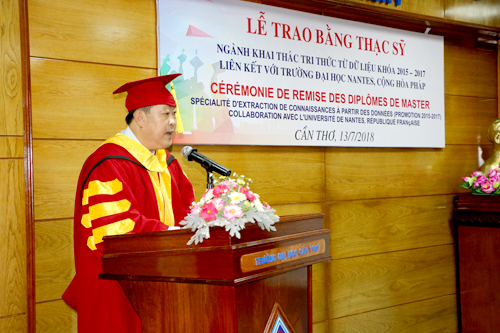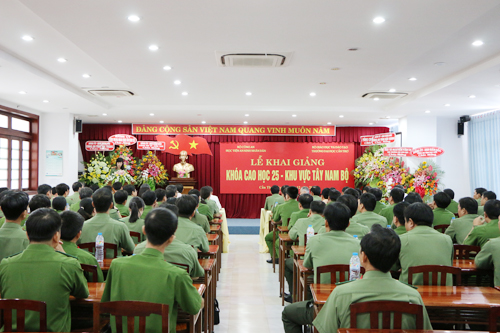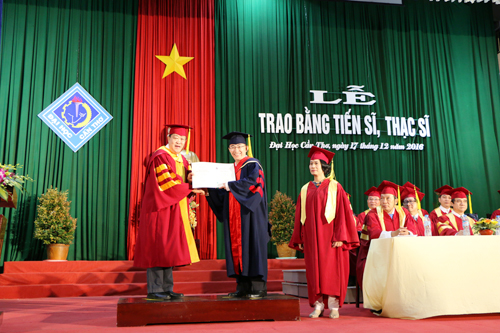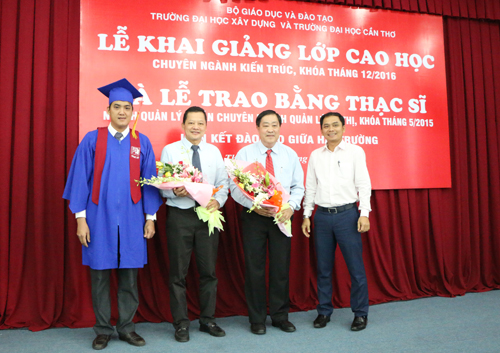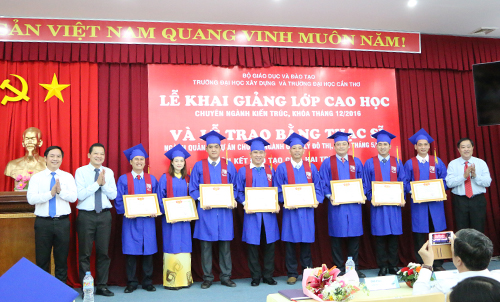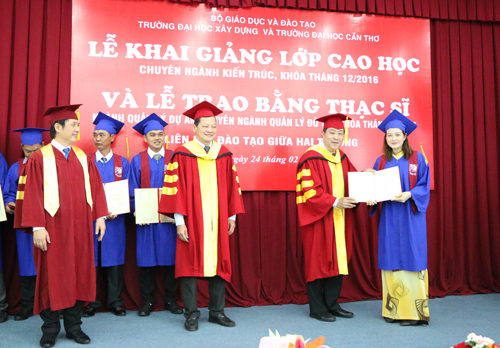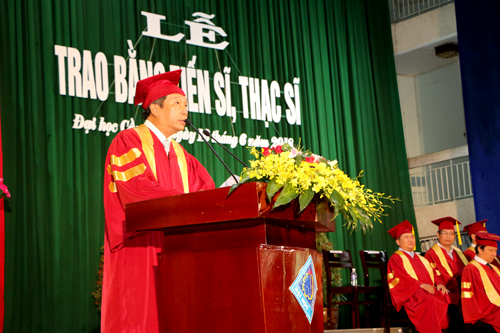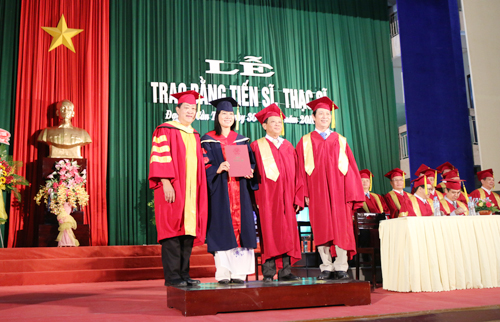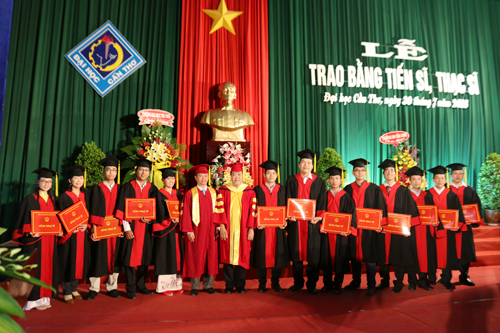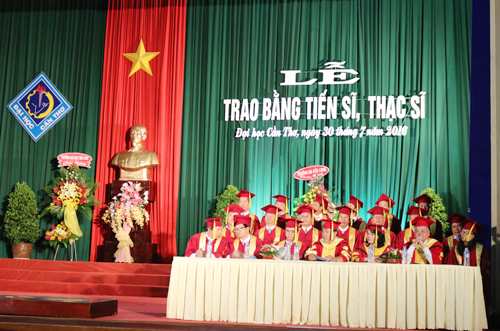
 Tên đề tài: “Nghiên cứu vi nấm trong nuôi cá tra (Pangasianodon hypophthalmus) và cá lóc (Channa striata) thâm canh” .
Tên đề tài: “Nghiên cứu vi nấm trong nuôi cá tra (Pangasianodon hypophthalmus) và cá lóc (Channa striata) thâm canh” .
 Tác giả: Đặng Thụy Mai Thy, Khóa: 2012
Tác giả: Đặng Thụy Mai Thy, Khóa: 2012
 Chuyên ngành: Nuôi trồng thủy sản; Mã số: 9620301. Nhóm ngành: Nông - Lâm - Ngư nghiệp
Chuyên ngành: Nuôi trồng thủy sản; Mã số: 9620301. Nhóm ngành: Nông - Lâm - Ngư nghiệp
 Người hướng dẫn chính: PGS.TS. Phạm Minh Đức, Trường Đại học Cần Thơ.
Người hướng dẫn chính: PGS.TS. Phạm Minh Đức, Trường Đại học Cần Thơ.
 Người hướng dẫn phụ: PGS.TS. Trần Thị Tuyết Hoa, Trường Đại học Cần Thơ.
Người hướng dẫn phụ: PGS.TS. Trần Thị Tuyết Hoa, Trường Đại học Cần Thơ.
 Thời gian bảo vệ: 8 giờ 00, thứ sáu ngày 26 tháng 01 năm 2018.
Thời gian bảo vệ: 8 giờ 00, thứ sáu ngày 26 tháng 01 năm 2018.
 Địa điểm bảo vệ: Phòng Bảo vệ luận án tiến sĩ (Phòng họp 3, lầu 2, Nhà điều hành), Khu II – Trường Đại học Cần Thơ
Địa điểm bảo vệ: Phòng Bảo vệ luận án tiến sĩ (Phòng họp 3, lầu 2, Nhà điều hành), Khu II – Trường Đại học Cần Thơ
- Tóm tắt nội dung luận án
Vi nấm là một trong những tác nhân gây bệnh ở cá tra (Pangasianodon hypophthalmus) và cá lóc (Channa striata) nuôi ao thâm canh. Nghiên cứu được thực hiện nhằm xác định đặc điểm bệnh học; sinh học của vi nấm gây bệnh trên cá tra và cá lóc; hóa chất và thảo dược sử dụng phòng trị bệnh vi nấm làm cơ sở đề xuất biện pháp phòng và trị bệnh do vi nấm. Kết quả nghiên cứu đã xác định được: (i) chín (09) giống vi nấm gồm Achlya, Protoachlya, Saprolegnia, Mucor, Rhizopus, Acremonium, Aspergillus, Fusarium và Tricoderma xuất hiện trong môi trường nước ao nuôi cá tra và cá lóc; (ii) năm (05) giống vi nấm gồm Achlya, Saprolegnia, Mucor, Aspergillus và Fusarium được phân lập từ cá tra bệnh. Cá tra bị trương bóng hơi có tỉ lệ nhiễm Fusarium đến 94,8%; (iii) năm (05) giống vi nấm gồm Achlya, Protoachlya, Saprolegnia, Aspergillus và Fusarium phân lập được từ cá lóc bệnh.
Nghiên cứu xác định đặc điểm bệnh học của vi nấm gây bệnh trên cá tra cho thấy Fusarium incarnatum-equiseticomplex (FIESC) là tác nhân gây bệnh trương bóng hơi trên cá tra và chủng F1509 có khả năng gây bệnh cao nhất.Mô bóng hơi cá tra bệnh bị biến đổi, cấu trúc của các lớp tế bào biểu mô, mô sợi và mô liên kết bị thoái hóa và hoại tử. Đặc biệt, nhiều sợi nấm xâm nhập bên trong các xoang bóng hơi bị trương lên.
Kết quả nghiên cứu xác định 5 chủng Achlya bisexualis có khả năng gây bệnh trên cá lóc trong đó chủng ĐT0232 có độc lực cao nhất. Cá lóc mẫn cảm với vi nấm A. bisexualis hơn cá tra. Nghiên cứu mô bệnh học ghi nhận nhiều sợi nấm xuất hiện trên vết thương ở da, tế bào biểu mô bị hoại tử. Hiện tượng thoái hóa được ghi nhận ở lớp biểu bì, lớp bì và dưới cơ. Sợi nấm nhiễm vào lớp biểu bì đến cơ với sự xuất hiện của một vài u hạt xung quanh sợi nấm.
Đặc điểm sinh học của FIESC và A. bisexualis giống nhau. Nhiệt độ thích hợp cho hai loài này phát triển từ 28-33°C, pH 6-8, độ mặn 0-0,5%. Vi nấm sử dụng carbohydrate chủ yếu là glucose và sucrose. Trong môi trường có NO2 nồng độ 5mM thì FIESC và A. bisexualis có thể tồn tại và phát triển.
Bronopol và iodine ức chế FIESC ở nồng độ ≥400 mg/L và CuSO4 ≥200 mg/L. Vi nấm A. bisexualis bị ức chế ở nồng độ bronopol và CuSO4 ≥100 mg/L; iodine ≥200 mg/L. Cỏ mực ức chế sự phát triển của A. bisexualis và Fusarium incarnatum-equiseti complex tốt hơn diệp hạ châu. Sử dụng thức ăn bổ sung 10 g cỏ mực /kg thức ăn có hiệu quả hạn chế nhiễm vi nấm trên cá tra và cá lóc.
- Những kết quả mới của luận án:
Xác định và sưu tập thành phần giống loài vi nấm trong môi trường ao nuôi thâm canh cũng như vi nấm nhiễm trên cá tra và cá lóc.
Xác định vi nấm Fusarium incarnatum-equiseti complex (FIESC) là tác nhân gây bệnh trương bóng hơi ở cá tra. Ứng dụng phương pháp truyền thống và sinh học phân tử xác định các đặc điểm hình thái, di truyền và sinh học của các chủng FIESC gây bệnh. Mô tả đặc điểm mô bệnh học bóng hơi bị bệnh do FIESC.
Xác định vi nấm Achlya bisexualis có khả năng gây bệnh trên cá lóc. Ứng dụng phương pháp truyền thống và sinh học phân tử để xác định các đặc điểm hình thái, di truyền và sinh học của các chủng A. bisexualis gây bệnh. Đồng thời mô tả biến đổi cấu trúc mô da cơ cá lóc bị nhiễm vi nấm A. bisexualis.
Đánh giá tác động của hóa chất và thảo dược đến Fusarium incarnatum-equiseti complex và Achlya bisexualis và thử nghiệm sử dụng cỏ mực phòng bệnh do hai loài vi nấm này gây ra.
- Các ứng dụng/khả năng ứng dụng trong thực tiễn, các vấn đề cần tiếp tục nghiên cứu:
Kết quả nghiên cứu của luận án nhằm bổ sung dẫn liệu khoa học về vi nấm trong môi trường ao nuôi cá và đặc điểm bệnh học của vi nấm gây bệnh trên cá tra và cá lóc. Các phương pháp và kết quả của nghiên cứu có thể được ứng dụng trong nghiên cứu về bệnh do vi nấm trên cá nuôi. Luận án là nguồn tư liệu phục vụ cho công tác giảng dạy và nghiên cứu khoa học.
Nghiên cứu đã đánh giá ảnh hưởng của hóa chất và thảo dược đến vi nấm gây bệnh, đây là cơ sở khoa học cần thiết để đề xuất các giải pháp hiệu quả trong phòng và trị bệnh do vi nấm nhiễm trên cá tra và cá lóc.
- Research Abstract
Fungi have been one of the pathogen causing diseases on striped catfish (Pangasianodon hypophthalmus) and snakehead fish (Channa striata) cultured in intensive ponds. The aim of the present study is to investigate pathogenic and biological characteristics of some disease-causing fungi on striped catfish and snakehead and to evaluate effects of chemicals and herbal extracts on the prevention and treatment of fungal diseases as the basis for the management of these diseases. Results showed that (i) nine fungal genera Achlya, Protoachlya, Saprolegnia, Mucor, Rhizopus, Acremonium, Aspergillus, Fusarium và Tricoderma were identified from the water samples; (ii) five fungal genera Fusarium, Aspergillus, Achlya, Saprolegnia and Mucor were identified from striped catfish. Fusarium was detected as the causative agent of swollen swim bladder in striped catfish with a high infection rate of 94.8%; (iii) five fungal genera Achlya, Protoachlya, Saprolegnia, Aspergillus và Fusarium were identified from snakehead.This study showed that Fusarium incarnatum-equiseti complex (FIESC) caused swollen swim bladder in striped catfish and the F1509strain had the highest virulence. Change was spotted in the swim bladder tissues structure, and the epithelial cell, fibrio and connective tissue showed degeneration and necrosis. A dense presence of fungal hyphae was found in the sinus of swollen the swim bladder.
Another result was that the five strains of Achlya bisexualis were the causative agents in snakehead, of which the ĐT0232 strain had the highest virulence. Snakehead was sensitive to fungal diseases more than striped catfish. A histopathological examination of the snakehead skin showed degeneration in the epidermis, dermis and underlying muscle. The hyphae were observed to penetrate into the epidermis to the musculature with some granulomatous response surrounding the hyphae.
Biological characteristics of Achlya bisexualis and Fusarium incarnatum-equiseti complex were the same. The optimal temperature of FIESC ranged from 28oC to 33oC, pH level was 6-8 and salinity was 0-0,5%. The strains could use glucose and sucrose. FIESC and A. bisexualis could survive and grow in the media supplied with nitrite (5mM).
Bronopol and iodine inhibited FIESC at the concentration ≥400 ppm and CuSO4 at ≥200 ppm. Similarly, Achlya bisexualis was inhibited with concentrations of bronopol and CuSO4 at ≥100 ppm, iodine at ≥200 ppm. False daisy (Eclipta prostrata) showed better inhibition than chamber bitter (Phyllanthus niruri) extracts in the hyphal growth of A. bisexualis and Fusarium incarnatum-equiseti complex. Using false daisy with the concentration of 10g/kg was effective with fungal diseases on both P. hypophthalmus and C. striata.
- Research Creativeness
Identification and collection of fungal species in cultured intensive system as well as fungal infections on striped catfish and snakehead.
Determination of Fusarium incarnatum-equiseti complex (FIESC) as the causative agent of swollen swim bladder in striped catfish. Application of traditional methods and molecular biology to determine the morphological, genetic and biological characteristics of FIESC strains. Description of histopathology of swim bladder in fish caused by FIESC.
Identification of Achlya bisexualis as a causative agent in snakehead fish. The use of traditional methods and molecular biology to determine the morphological, genetic and biological characteristics of pathogenic A. bisexualisstrains. Description of the histology change of snakehead muscle infected with A. bisexualis.
Assessment of the effects of chemicals and herbal extract on Fusarium incarnatum-equiseti complex and Achlya bisexualis. Experimental use of false daisy to prevent these two fungal species.
- Practical implications from study
The results of this study will update the scientific knowledge on fungal species in fish ponds and pathogenic characteristics of fungal strains on striped catfish and snakehead. The methods and results of the study may be applied in investigations of fungal diseases on cultured fish. The dissertation is a source of material for teaching and scientific research.
The present research has evaluated the effects of chemicals and herbal extract on pathogenic fungi, thus serving as an essential basis for the prevention and control of fungal infections in striped catfish and snakehead.
>> Xem chi tiết nội dung luận án
>> Xem thông tin đăng tải tại Website Bộ giáo dục và Đào tạo.





